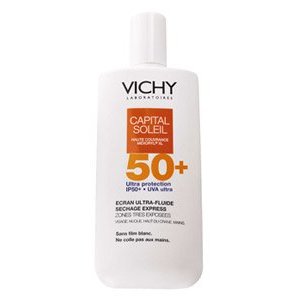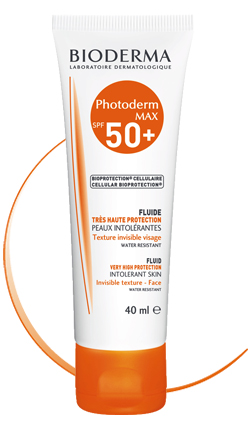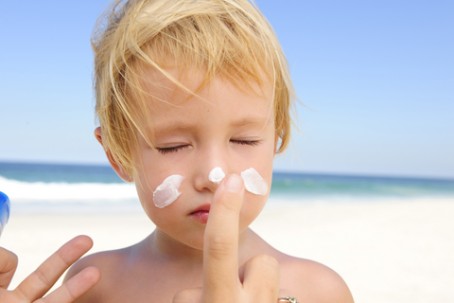I usually don’t preface my posts. But, thanks for being patient on the release of this post. There was a lot of information to devour and for some reason I had a hard time writing it. I hope this is useful and written plainly and clearly! At 2,000 words, I know it is long but it beats the pages and pages that are online. If you are pressed for time skip down to the summary tips.
It is that time of the year where we will all be enjoying the good weather… outdoors. Meaning, we will all be getting more sun exposure. While sun exposure is crucial to stimulating the skin to produce Vitamin D, prolonged sun exposure increases the risk of melanoma. As any health conscious person or parent, we slather sunscreen onto ourselves and our children. But wait! Can that sunscreen be detrimental to all of our health? The answer is YES!
The Environmental Working Group’s (EWG) recently released sunscreen guide reveals that 60% of sunscreens in the United States are inadequate against protecting against UVA radiation. The guide reviewed 292 brands and 1700 products. It ranked products 0-2 for low hazard, 3-6 for moderate hazard and 7-10 for high hazard.
As an aside, UVA rays comprise 95-97 % of the UV radiation that gets through our atmosphere while UVB only 3-5%. UVB penetrates on the surface of the skin while UVA penetrates deeper and may cause DNA damage. Furthermore, many of the sunscreens in the United States contain chemicals hazardous to our health.
My goal with this post is to equip you with knowledge to choose a safe sunscreen. What the post will not do is go into the controversies: Do sunscreens increase risk for melanoma? Can they lead to vitamin D deficiency? Etc.
Types of Sunscreens
Bear with me, I will try and not bore you with anything too scientific.
Sunscreens have not been regulated since 1978 in the USA. SPF factor only tells you how effective a sunscreen is against UVB rays which cause sunburn. Currently, US sunscreens are not rated for how protective they are against UVA rays.
There are two types of sunscreens: non-mineral and mineral. And some that combine both.
The non mineral sunscreens penetrate the skin, are potentially disruptive to hormones, are allergenic, and have inferior stability at the skin surface (think free radical production when they break down). One such example is oxybenzone, the most common ingredient found in sunscreens. Scientists recommend not using sunscreens containing oxybenzone on children because of this hormone disruption. A safer non-mineral sunscreen is one containing avobenzone.
Mineral sunscreens are ones containing zinc, or titanium. These do not breakdown in sunlight, are not usually absorbed ( so do not disrupt the body’s hormones), are not allergenic and are more effective at blocking UVA rays than non-minerals. These sunscreens are a good choice for children and according to EWG have the best safety profiles of the choices in the United States.
There are more effective minerals: Mexoryl, Tinosorb-M and Tinosorb-S. All three of these are 3-5 times more effective than avobenzone.
Unfortunately, Mexoryl is not readily available in the USA. Loreal has only been approved to use Mexoryl in their La-Roche Posay brand. But be careful, two of the sunscreens reviewed in this line do not contain Mexoryl but do contain oxybenzone. The two that do contain Mexoryl despite being given a level 2 and 3 rating contain the hazaradous chemicals: methylparaben and propylparaben (both are hormone disrupters) and triethanolamine. Mexoryl has been widely available in Europe since 1991however.
Tinosorb has not been approved for use in the USA although one company applied for FDA approval… back in 2005. They are still waiting.
What makes sunscreens hazardous to our health?
There are two major substances to avoid when buying sunscreens: oxybenzone and Vitamin A which is found in sunscreens as retinyl palmitate. These are unfamiliar words to many of us and may be difficult to remember. Write them down on a slip of paper and put it in your wallet or purse. The next time you are at the pharmacy or grocery store, pull the paper out and see how many sunscreens on the shelf contain one or the other or both.
What did you find? You will find that most sunscreens on the store shelves contain one, the other or both chemicals. The brands commonly seen on the US shelves include: Coppertone, Aveeno, Nuetrogena, Bull Frog, And Banana Boat to name some.
I remember my parents using Coppertone on us as kids. And I have used it on my own children. I am just horrified thinking of all the toxins we have been exposed to.
Oxybenzone
What makes oxybenzone so hazardous? It absorbs through the skin. Anything that absorbs through the skin can have effects on the whole body (systemic effects). Oxybenzone is potentially disruptive to our hormones. Think about this a little. How many food items (milk, meat etc) contain hormones? It seems as if we are being bombarded by hormones unnecessarily every day.
What I have seen clinically is that the onset of menarche(start of a girl’s menstrual cycle) and menopause both have gotten younger and younger. At least, these are my observations over 14 years.
Retinyl Palmitate
Retinyl Palmitate is thought to be photocarcinogenic. Another big word meaning that when it is exposed to sun, it speeds the growth of skin tumors. It is added to 30% of all sunscreens.
You may ask, why would sunscreen manufacturers add retinyl palmitate to sunscreens? In addition to being protective against the sun, they are antioxidants and being a vitamin A derivative slow aging (for beauty). These photocarcinogenic properties were probably not known at the time they were added. Or at least this is what we hope.
There are many other chemicals added to some sunscreens which make them even more unsafe. Have a look through the sunscreens given a high hazard ranking (7-10) to find these additional chemicals. You will have to scroll down to the end of the page. The common pharmacy and grocery store brands dominate these high hazard sunscreens.
Lastly, many sunscreens are advertised as having a high SPF when in actuality they don’t. This makes it dangerous for those using the sunscreen as they expect to get long lasting protection. Banana Boat Sport Performance Active Max Protect, SPF 110 sunscreen is one example. It is estimated to have an SPF of 12 not 110. This one was listed in the EWG “Hall of Shame”.
Why is nothing being done? The FDA was supposed to regulate sunscreens in 1978 but has not done so. Hopefully, with the recent EWG guide being released, regulations will be expedited. But until sunscreens in the United States are regulated, we can only be proactive.
What is one to do?
There are three things we can do: implement conservative measures against UVA and UVB rays, buy only the sunscreens listed with a low hazard ranking on the EWG guide or seek out the safer European mineral sunscreens. The later you can buy online despite that they cannot be manufactured in the USA.
Conservative measures include wearing protective clothing, wearing wide brim hats, seeking shade and avoiding midday sun. But for most outdoor enthusiasts, this is not practical.
Many of the sunscreens that have a low hazard rating are not sold in stores. You will likely have to buy them online. And unfortunately, they are higher priced than the ones commonly sold in stores.
I took the liberty of reviewing the prices of three sunscreens ranked a level 1, meaning low hazard. Of those given a 1 ranking, I took the time to look at each and every chemical listed in the sunscreen. This helped me to exclude some formulations given a level 1 ranking but contained individual ingredients ranking higher.
Here were several good choices I found given a ranking of 0-2 (low hazard) for all chemicals: California Baby was $19.99 for a 2.9 ounce tube, Badger $16.00 for 2.9 ounces and Aubrey Organics 11.96 for 4 oz.
Another alternative is to buy sunscreens containing Mexoryl ,Tinosorb-M or Tinosorb-S. Although they are not manufactured in the USA, they are readily available online. See below for some links. Or if you are like my favorite expat couple John and Ammena Falchetto who live in Provence, France, you can pop down to your local pharmacy and pick from a plethora of safe brands. If you haven’t read either of their blogs, you should.
What I use
While my choices for sunscreen for my body and my children may not have been safe until recently, I have been fortunate enough to happen upon two safe (and effective) products that I have been using on my face for years.
 The first is Vichy Capital Soleil Protective Micro-Fluid Face 50+. You can find it online here. I wear Vichy under my makeup every day. It dries a nice mat so no shine. Vichy’s sunscreen contains Mexoryl XL. The XL formulation is slightly more effective than the Mexoryl SX found in the US.
The first is Vichy Capital Soleil Protective Micro-Fluid Face 50+. You can find it online here. I wear Vichy under my makeup every day. It dries a nice mat so no shine. Vichy’s sunscreen contains Mexoryl XL. The XL formulation is slightly more effective than the Mexoryl SX found in the US.
I purchased Vichy’s product from France (and had it shipped to the USA) in 2002 after reading an article in Harper’s Bazaar touting the benefits of Mexoryl It is readily available abroad where we live now.
 The second product I have been using since 2005 is Bioderma’s Photoderm Max. I use this when we are at the beach. It contains both Tinosorb-M and S. Remember, the Tinosorb’s are the most effective and safest minerals you can use I buy this readily abroad as well. It is found easily online here. It used to carry an SPF rating of 100 but European regulations will soon no longer allow a rating higher than 50. The same will go in the USA if regulations are passed
The second product I have been using since 2005 is Bioderma’s Photoderm Max. I use this when we are at the beach. It contains both Tinosorb-M and S. Remember, the Tinosorb’s are the most effective and safest minerals you can use I buy this readily abroad as well. It is found easily online here. It used to carry an SPF rating of 100 but European regulations will soon no longer allow a rating higher than 50. The same will go in the USA if regulations are passed
An experiment for you or not?
I was going to recommend that you bring your list of hazardous chemicals to your local pharmacy/grocery to see if you could pick out a safe sunscreen. Sounds easy? I thought so too…until I had to buy a sunscreen at the last minute. I scanned the shelves at Safeway and quickly excluded almost all the sunscreens found based on the presence of either oxybenzone or retinyl palmitate. I came across Nuetrogena pure and free baby 60+ sun block lotion which I thought was safe. It has avobenzone in it which is safe.
I should have known by the smell (despite being fragrance free) that it was not a good choice. I reviewed it on EWG’s guide after I returned from my hike only to find it was given a 7 (high hazard) rating. I failed to notice that it does contain retinyl palmitate. The print on the bottle is relatively small… or at least that was my excuse. It also contained other chemicals that are toxic: alumina, benzyl alcohol, BHT, and methylisothiazolinone. All of these were rated a 6 (high hazard).
How can anyone remember all these chemicals? After this experience, I would recommend that you buy from Europe via online sites or take the EWG guide to the store with you and buy only what has been reviewed.
Summary
• The FDA started to develop sunscreen regulations in 1978 but never completed them. This makes it possible that every sunscreen produced can be hazardous
• SPF only tells you how protective a sunscreen is against UVB rays, which cause sunburn
• UVA protection of sunscreens is not rated in the United States
• The safest and most effective minerals in the USA are zinc, titanium and Mexoryl SX
• The safest minerals outside of the USA are Tinosorb-M and Tinosorb-S
•The two most hazardous chemicals to avoid are: Oxybenzone and retinyl palmitate
•There are so many unsafe chemicals added to sunscreens. It is hard to know them all: buy from the EWG guide or rely on European made sunscreens
• If you live in Europe in abroad likely you will have the safest sunscreens at your disposal but be sure to read the ingredients on the bottle.
Discussion
What sunscreens have you been using for yourself? Your Children? Will you be making a change? I know I will.
I am not receiving any compensation for letting you know my two favorite products. This was an independent review.























My gratitude for your always comprehensive, medically sound–and personal–review. Read 6/16 NYTimes articles; listened to Diane Reams’s program, “Sunscreen Labels and Skin Cancer,” NRP radio —
only your analysis answers critical questions and provides solutions
Dear Sue
Wow, what a compliment! I am so happy that my review was helpful. Now if only we can get stores to stock the safer varieties more readily!
Fondly,
Rajka
I found out that my sunscreen for my 2-yr old is terrible – huggies spray for kids. I promptly threw it away (thank goodness Seattle has only had a handful of sunny days so far!).
I went to the supermarket to find something on the good list and could only find Kiss My Face in the natural food section. However, the website doesn’t even rank what I found – “kiss my face, obsessively natural kids natural mineral sunblock lotion”. Any thoughts or info you have on this brand is greatly appreciated.
Hi Jessica
Thanks for sharing. It looks many of us moms were in the same boat. You go to the grocery or pharmacy and choose the one that says babies or kids thinking you will be ok…
Interestingly enough the FDA released guidelines today. However, it will limit SPF to 50 and also ensure that the sunscreens will protect against UVA rays… No mention of eliminating the hazardous chemicals. Here is the link: http://www.npr.org/blogs/health/2011/06/15/137175140/fda-sunscreens-will-get-more-scrutiny-new-labels?ps=sh_sthdl
Will get back to you on the Kiss my Face sunscreen… hadn’t heard of it.
Cheers,
Rajka
This is my type of info! Most people are clueless on who dangerous sunscreens can be in the long run. To be honest, you most people are better off not using most of the commercial brands offered.
You may wonder how in the world would I know about this. Well, for one I’m a researcher (of many topics), but as you saw on my most recent post – my kids have a need for sunscreen (unlike myself), so my wife and I are very particular in what we purchase because we are aware of the dangers.
Very good message to spread – thanks for sharing Rajka!
You are very welcome JK!
Glad you found the post informative! I worked hard on this one. It is so shocking. You cannot go to the store and just buy a good/safe sunscreen. You have to order one usually!
And those kids of yours are cute as buttons!
Glad to see you on the site!
cheers,
Rajka
I am confused – the Bioderma Photomax is FILLED with parabens! How can that be better?
Dear Three Peas
Thanks for bringing this to my attention. I have just pulled my bottle of Bioderma. The ingredients are not listed on the bottle. Will have to look at the packaging at the pharmacy next time.
But, if you say it contains parabens, then another point is proven. It is too difficult to remember which sunscreen has what toxic ingredient. So, I will stand with my summary recommendation of choosing a sunscreen off the EWG’s list that ranks 0-2 for all components. Sadly, these are the priciest.
Thanks for your feedback.
Rajka
Dear Three Peas
I have the bottle of Bioderma in front of me now in the box which lists the ingredients none of which are parabens. Wikipedia lists parabens as the following: Parabens are esters of para-hydroxybenzoic acid, from which the name is derived. Common parabens include methylparaben (E number E218), ethylparaben (E214), propylparaben (E216) and butylparaben. Less common parabens include isobutylparaben, isopropylparaben, benzylparaben and their sodium salts.
None of the above parabens are listed under ingredients.
Where did you get your info?
I will be scrutinizing each individual ingredient in the Bioderma sunscreen for safety and will post a follow up reply soon.
Regards,
Rajka
Dear Three Peas
I have the bottle of Bioderma in front of me now in the box which lists the ingredients none of which are parabens. Wikipedia lists parabens as the following: Parabens are esters of para-hydroxybenzoic acid, from which the name is derived. Common parabens include methylparaben (E number E218), ethylparaben (E214), propylparaben (E216) and butylparaben. Less common parabens include isobutylparaben, isopropylparaben, benzylparaben and their sodium salts.
None of the above parabens are listed under ingredients.
Where did you get your info?
I will be scrutinizing each individual ingredient in the Bioderma sunscreen for safety and will post a follow up reply soon.
Regards,
Rajka
The link you provided for buying Bioderma lists the ingredients and the last three are parabens. Not sure why your bottles don’t show them. Which is correct, I wonder?
Hi,
I think that maybe the difference in ingredients list comes from the fact that Rajka got her ‘european’ version of Bioderma. I currently live in France and noticed that a lot of cosmetic products are advertised as ‘paraben-free’. I have checked the amazon.com website for bioderma, and in there, bioderma contained 3 parabens just as you said. So, best to get it from the french pharmacy or the french version of it.
I thought the Bioderma version on Amazon was the euro version. I also ordered the La Roche Posay Anthelios 50 Dermo-kids euro version- IT IS PARABEN FREE!
Thanks for the info Irene! Will keep this in mind for when we eventually move back to the USA and don’t have ready access to European sunscreens!
Anne
Thanks for clarifying this! I did not note parabens on the “European” version purchased in Qatar!
Best,
Rajka
Dear Three Peas
I have the bottle of Bioderma in front of me now in the box which lists the ingredients none of which are parabens. Wikipedia lists parabens as the following: Parabens are esters of para-hydroxybenzoic acid, from which the name is derived. Common parabens include methylparaben (E number E218), ethylparaben (E214), propylparaben (E216) and butylparaben. Less common parabens include isobutylparaben, isopropylparaben, benzylparaben and their sodium salts.
None of the above parabens are listed under ingredients.
Where did you get your info?
I will be scrutinizing each individual ingredient in the Bioderma sunscreen for safety and will post a follow up reply soon.
Regards,
Rajka
Dear Three Peas
I have the bottle of Bioderma in front of me now in the box which lists the ingredients none of which are parabens. Wikipedia lists parabens as the following: Parabens are esters of para-hydroxybenzoic acid, from which the name is derived. Common parabens include methylparaben (E number E218), ethylparaben (E214), propylparaben (E216) and butylparaben. Less common parabens include isobutylparaben, isopropylparaben, benzylparaben and their sodium salts.
None of the above parabens are listed under ingredients.
Where did you get your info?
I will be scrutinizing each individual ingredient in the Bioderma sunscreen for safety and will post a follow up reply soon.
Regards,
Rajka
Yikes. Just threw away 10 bottles/tubes of sunscreen. (That in itself is a bit embarrassing to admit – who has that much excess? Oh, that’s right a guilt-ridden, forgetful mother, that’s who!)
The best option in my arsenal was rated a 4. I’m holding on to that one until my order for Aubrey Organics shows up; I just haven’t decided if I will use it or not in the meantime. It scored a 1, 2 or 3 for all ingredients except fragrance which was an 8! Makes me a bit nervous of all the other “fragrance” products in my bathroom.
Thanks again, Rajka for a very informative article!
Love the visual Mary Ann! It was much the same in our house and I see some of the same products in your garbage that was in mine when I first did the review.
After doing this review, it made me leery of all the products in our home including beauty. It may be time for another product review!
Take care,
Rajka
Hi Rajka, thank you so much….this is so what I’ve needed to find regarding info on sunscreen, but you’ve done all the hard work for me even though I don’t live your side of the world! Living on the QLD coast in Australia, in theory I “should” apply sunscreen to my children’s exposed areas pretty much every day (that’s all year round too), but I don’t. It doesn’t feel right, it never has, I know what’s in most of these products and I actually avoid sunscreen at all costs except for the days that I send them off to pre-school/kindy and just have no control over their exposure to the sun out in the play-grounds
I’ve lots to look up now from your recommendations and thank you for such valuable information.
You are most welcome Anna!
Avoiding all sun and complete use of sunscreen is likely making all of us Vitamin D deficient. So I don’t think you are too far off track! I hope you find a sunscreen that agrees with you to use when you and your family are in direct sunlight for prolonged periods of time!
Sunscreen can obviously be very dangerous. About a month ago I went to the tropics and applied Nivea sunscreen (30) and ended up with dark brown patches on my left arm. It looks like burnwounds. I haven’t consulted a dermatologist yet, as I waas hoping for it to go away. However, the patches are still there. What would you recommend I do?
Allison
This is great! I have been trying to look into since last year when I was looking for a sunscreen that would not react with my childrens skin. This is everything I have found rolled up in 1. In canada I have found http://www.en.vichy.ca/Capital-Soleil/Body-and-Face-protection/Children-s-LOTION-SPF-50-FACE-AND-BODY-p949.aspx it runs around $30 at shoppers drug mart. I am however going to look the next time I am in the US for http://www.coppertone.com/coppertone/products/SensitiveSkin/index.jspa it ranks a 2 on thehttp://breakingnews.ewg.org/2011sunscreen/. I wish there was something like this site for canadian products. Next I am going to be looking at myself. I use Mary Kay products and will be interested in what is in them!
Glad you liked the article Mackenzie!
I think it wise that we all look at the beauty products we use. Anything put on our skin is aborbed. You want to ensure whatever is used is safe!
Best,
Rajka
Mackenzie
Glad you liked the article. On the coppertone product, from recollection, most of the coppertone products had a poor rating… Will have to check this out.
Best,
Rajka
I do have a silly question for you. Do I get the vitamin D from the sun only when my skin is exposed directly to the sun? I have always had in question in my mind.
Thank you,
Maryam
Yes, it has to be direct exposure. Keep in mind that you are still getting exposure during cloudy days.
Yes, it has to be direct exposure. Keep in mind that you are still getting exposure during cloudy days.
What’s the best usage of
sunscreen with makeup? I’ve just started using makeup (18 years old with
strict parents) so I’m a little behind on things.
Dear Lydelle
So sorry on the delay. It appears that I am not getting all my message notifications form disqus.
To understand your question, you want know best usage of makeup with SPF. It would be worn when you are out and about in the sun rather than when you will be indoors.
2 caveats: you can still get sun exposure through windows when you are indoors so be aware. I also feel that a separate sunscreen worn under your makeup is better than wearing a combination SPF/makeup product.
I hope this helps.
For new makeup wearers and in general, I like the book “Making Faces” by Kevin Aucoin. http://www.amazon.com/Making-Faces-Kevyn-Aucoin/dp/0316286850/ref=sr_1_1?s=books&ie=UTF8&qid=1346526315&sr=1-1&keywords=making+faces
Hello,
Im a little confused. The Vichy sunscreen you use has Oxybenzone in it.
Or is there another one that doesn’t ?
Regards,
Rebecca
R Devereux, did you get the answer to your question, I also looked at the Vichy site and every sunscreen had Oxybenzone in it. Thanks
I have just bought Bioderma photoderm max fluid with 100 SPF .. and then I heard that they have stopped selling it in Europe as it has a 100 SPF which means a lot of chemicals .. so could u plz tell me if there are any dangers or side effects if I kept using it ??
I am trying to buy bioderma kids after reading your article but when I read the ingredient list, do you know it contains every paraben possible?
I posted this same response awhile back to another reader. Where are you buying your bioderma? The reason I ask as sunscreens sold/made in the USA even the same brands have different ingredients. I bought my bioderma abroad. I did not order it through amazon.
I had a look on the ingredients list several times… see my original response earlier in this thread
“Dear Three Peas
I have the bottle of Bioderma in front of me now in the box which
lists the ingredients none of which are parabens. Wikipedia lists
parabens as the following: Parabens are esters of para-hydroxybenzoic
acid, from which the name is derived. Common parabens include
methylparaben (E number E218), ethylparaben (E214), propylparaben (E216)
and butylparaben. Less common parabens include isobutylparaben,
isopropylparaben, benzylparaben and their sodium salts.
None of the above parabens are listed under ingredients.
Hello, I looked at the Vichy site and every sunscreen had Oxybenzone in it, is there a different one. What are some current sunscreens Europe that have Mexerol XL or Tinsorb 3/3/14. Thank you
Dr. Rajka, Excellent article- I am so grateful for your demystification of this issue and research!
I have Laura Mercier tinted moisturizer w/ octinoxate + avobenzene and smashbox primer with octinoxate and octisalate with 3/2012 expiry. is it ok to use them, not necessarily for the UV protection, and then to add a natural sunscreen with zinc and titanium dioxide on top for SPF protection. i.e. Is it ok to use those products for their basic purpose and to ignore the expired sunscreen ingredients in them? Thank you.
thanls fo a vey useful advice! recently i bought here in Europe ‘Avene spf 50+’, with their new product ‘SunSitive Protection’, from Pierre Fabre Research. Is it safe?
p.s.
this is the product i mentioned:
http://www.aveneindia.com/suncare/sunscreens-sensitive-skins/sunscreen-vhp-spf50-cream
Thanks for your useful recommendation. I am pregnant and I want to protect my skin under the sun, so whether vichy sun cream safe for me.
As a pregnant women you need also consider to stay more limited time under direct san for safety of baby and also you may want to cover your belly with damp towel/cloth etc. while laying in the sun
Hi, the link to where you recommend buying Bioderma from does not work…I am anxious to buy the correct one without parabens…can you provide another link? Or does this look ok: http://www.amazon.co.uk/gp/product/B001COZ48G/ref=pd_lpo_sbs_dp_ss_1?pf_rd_p=479289247&pf_rd_s=lpo-top-stripe&pf_rd_t=201&pf_rd_i=B002CZU0AG&pf_rd_m=A3P5ROKL5A1OLE&pf_rd_r=1X3EKRRGK7MP4CFPF9MT
Thanks for a great article!
SM
I use a line called substance. It is made in Canada. The active ingredient is Zinc Oxide and the only other ingredient in it that is not natural is Phenoxyethanol. I think that is a preservative.
It is mineral based and does make skin white, but I only use it on the beach. Any other time, we wear light cotton clothing and hats to cover skin.
Very timely. On any given day my brain is mostly fried and frazzled but even I understood this. Thanks. Off to the pharmacy I go or maybe I’ll just stay inside a bit longer…
Well now, I am sufficiently horrified at the sunscreen I have used on myself and my kids! I have looked and reviewed sunscreens in the past but this article was very eye opening, thank you. I have already ordered some of the products you recommend and can only hope that i’m now making better choices! Thank you Rajka!
Thanks Christine, I am so happy you understood the post! I worked hard to try and get it right!
I hear you maybe just staying inside a little longer!
Cheers,
Rajka
Thanks Julie for that info on “substance”. Will have to look it up! Here is to staying safe in the sun!
Cheers,
Rajka
Shellie
Hopefully, our youth is on our side and that now that we are both using safer products we will be all right!
Glad the post was helpful!
Rajka